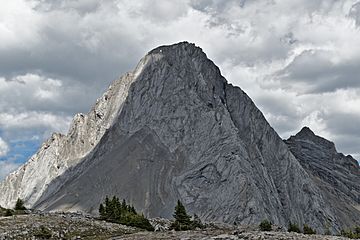Mount Birdwood facts for kids
Quick facts for kids Mount Birdwood |
|
|---|---|
 |
|
| Highest point | |
| Elevation | 3,097 m (10,161 ft) |
| Prominence | 735 m (2,411 ft) |
| Listing | Mountains of Alberta |
| Geography | |
| Location | Alberta, Canada |
| Parent range | Spray Mountains Canadian Rockies |
| Topo map | NTS 82J/14 |
| Climbing | |
| First ascent | 1922 by C.F. Hogeboom, F.N. Waterman, Rudolph Aemmer. |
Mount Birdwood is a tall mountain peak in the Spray Mountains range. It is part of the amazing Canadian Rockies in Alberta, Canada. This mountain stands at about 3,097 meters (10,161 feet) high. It is located right on the eastern edge of Banff National Park, in the beautiful Spray Lakes River Valley.
History of Mount Birdwood
Mount Birdwood got its name in 1919. It was named to honor Lieutenant General Sir William R. Birdwood. He was a very important military leader. He commanded the Australian Imperial Force (AIF) in France during a big war.
The mountain's name became official in 1928. This was decided by the Geographical Names Board of Canada. This group is in charge of naming places in Canada. The first time anyone successfully climbed to the top of Mount Birdwood was in 1922. The climbers were C.F. Hogeboom, F.N. Waterman, and Rudolph Aemmer.
How Mount Birdwood Was Formed
Mount Birdwood is made of different types of sedimentary rock. This kind of rock forms when layers of sand, mud, and tiny bits of ancient sea creatures settle over millions of years. These layers were laid down a very long time ago. This happened during periods known as the Precambrian and Jurassic times.
Imagine these rocks forming at the bottom of shallow seas. Later, powerful forces inside the Earth pushed these rock layers. They were pushed up and over younger rocks. This huge pushing and folding event is called the Laramide orogeny. It helped create the Rocky Mountains we see today.
Climate Around Mount Birdwood
The weather around Mount Birdwood is known as a subarctic climate. This means it has very cold and snowy winters. The summers are usually mild, not too hot. Temperatures can often drop below -20 degrees Celsius (-4 degrees Fahrenheit). With the wind, it can feel even colder, sometimes below -30 degrees Celsius (-22 degrees Fahrenheit).
When snow and ice on the mountain melt, the water flows down. This water goes into small streams. These streams then join the Spray River. The Spray River is a smaller river that eventually flows into the larger Bow River.




